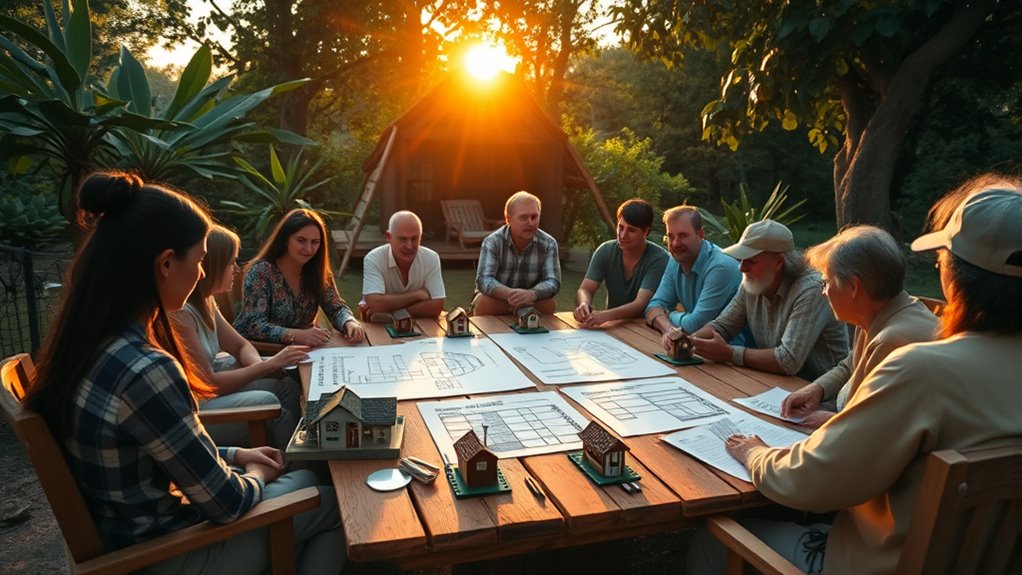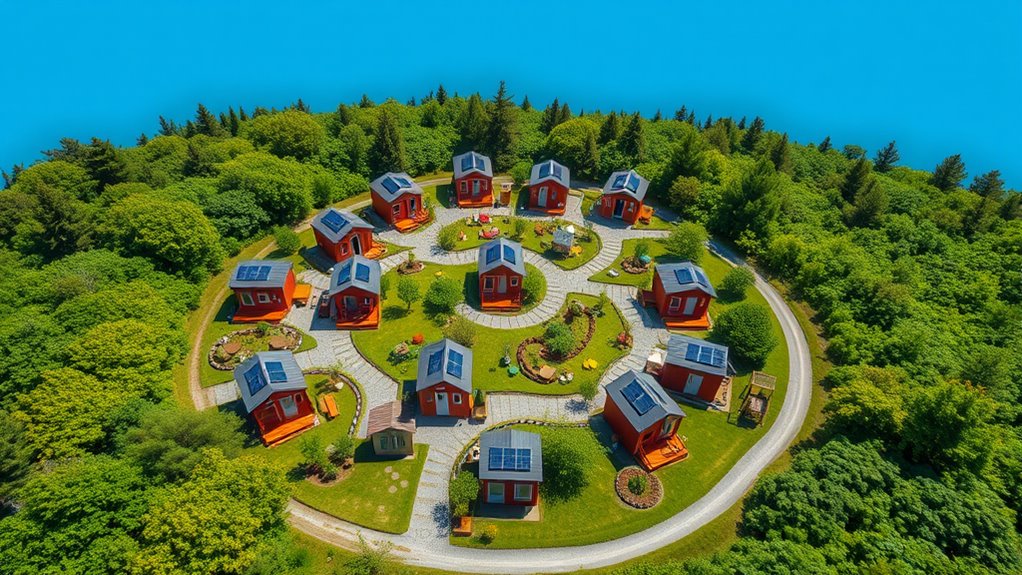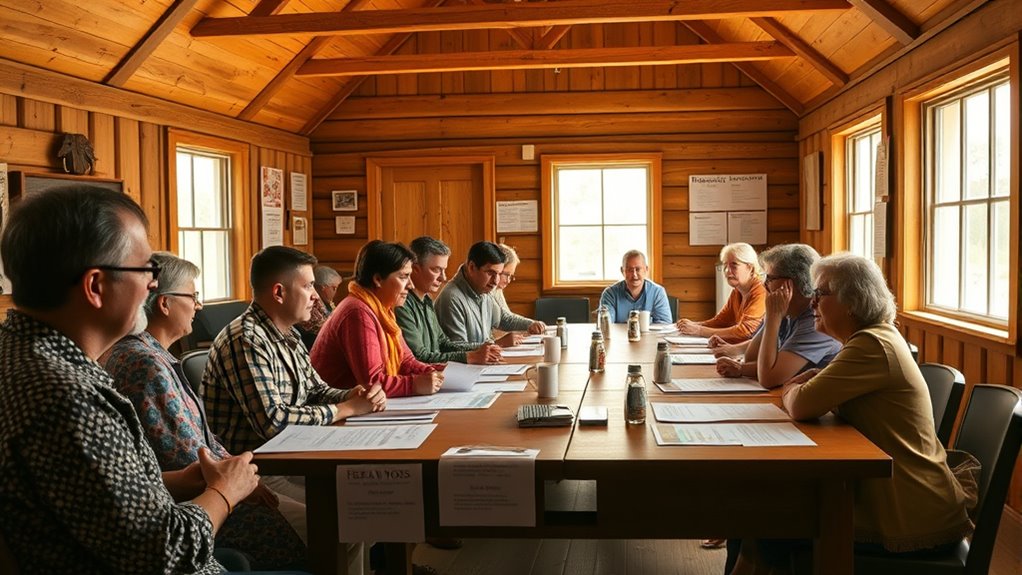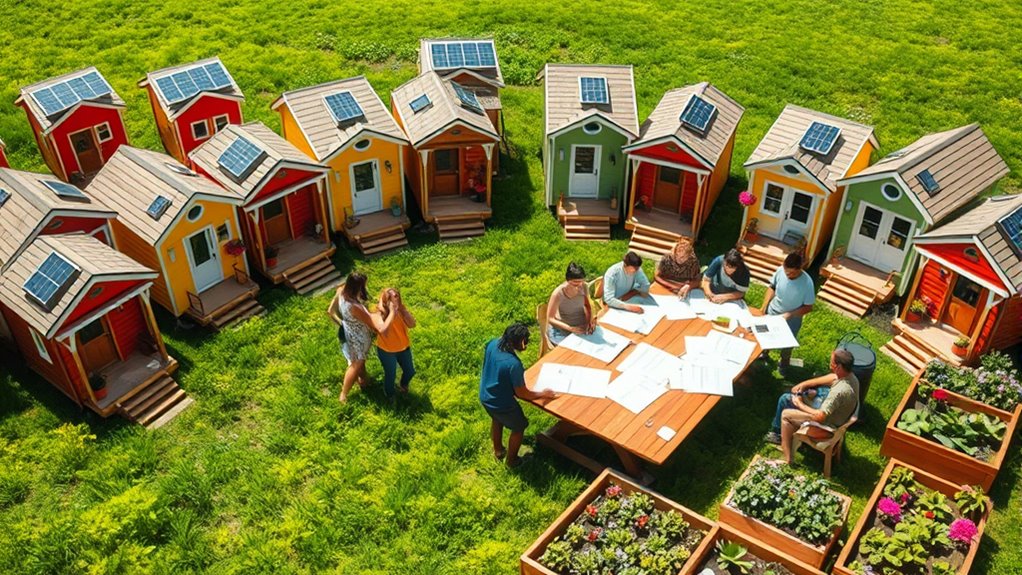To finance a cooperative tiny-house village, establish clear bylaws that outline shared ownership models, affordability protections, and resident participation rules. Incorporate community land trusts or limited equity cooperatives to maintain long-term affordability, and set up processes for capital contributions, grants, and shared expenses. Define property use restrictions, resale rules, and dispute resolution procedures to foster stability. Building these elements into your bylaws helps guarantee a sustainable, resident-driven community—more details on crafting these mechanisms await you.
Key Takeaways
- Incorporate diverse funding sources such as grants, public subsidies, charitable contributions, and community loans to finance the village.
- Establish shared-equity ownership models like CLTs and LECs to promote long-term affordability and community wealth.
- Define bylaws that specify residents’ financial contributions, including deposits, sweat equity, and participation fees.
- Set clear guidelines for resale restrictions, right-of-first-refusal, and rules linking stewardship rights to participation rather than ownership.
- Include provisions for dedicated maintenance funds, reserve accounts, and transparent budgeting to ensure financial sustainability.
Establishing Governance and Membership Structures

When establishing governance and membership structures for tiny-house villages, it’s essential to design systems that are simple yet effective. You want governance to be lightweight to reduce costs and delays but strong enough to resolve conflicts and build trust. Use resident councils to manage daily decisions like chores, events, and admissions through regular meetings. Incorporate participatory democratic processes to ensure everyone has a voice in policy-making. An executive team can coordinate with external staff and oversee operations. Conflict resolution should include restorative justice classes to maintain a healthy community culture. Membership can be defined by security deposits or fees, refundable upon departure. Require members to contribute sweat equity through maintenance and participation in weekly meetings. Rules against substance abuse and transfer restrictions help sustain stability and community integrity. Additionally, fostering emotional alignment among residents can enhance community harmony and resilience.
Incorporating Shared Equity and Affordability Provisions

Building on the foundations of governance and community participation, incorporating shared equity and affordability provisions helps guarantee tiny-house villages remain accessible over the long term. You can achieve this by using hybrid ownership models that combine Community Land Trusts (CLTs) and Limited Equity Cooperatives (LECs). The land stays under the CLT’s control, while residents own shares in the LEC, securing long-term affordability. Resale formulas, such as interest rates or inflation indices, regulate share prices and preserve affordability. These mechanisms ensure residents can build equity without sacrificing affordability. Additionally, including right-of-first-refusal clauses prevents shares from being resold at market rates, maintaining community stability. Implementing such provisions is essential for ensuring long-term affordability and community resilience. This approach balances wealth-building opportunities with ongoing access for low-income households. Incorporating long-term affordability strategies can further strengthen the sustainability of these cooperative models.
Defining Maintenance and Operational Responsibilities

Clearly defining maintenance and operational responsibilities is essential for the smooth functioning of tiny-house villages. You should establish a maintenance request system that allows residents to report issues promptly, ensuring timely repairs. Set routine maintenance schedules for tasks like filter changes, gutter cleaning, and inspections to prevent bigger problems. Allocate funds specifically for regular and major maintenance to avoid financial strain. Clearly assign roles for maintenance tasks and develop inspection protocols to catch issues early. For operations, assign responsibilities for utilities, landscaping, waste management, and emergency preparedness. Encourage community involvement through volunteer opportunities and feedback channels. Regularly review budgets and maintain reserve and maintenance funds. Effective management practices help prevent costly repairs and ensure the safety and comfort of residents. Incorporating preventive maintenance strategies can further enhance the longevity of village infrastructure. These clear definitions and systems promote accountability, efficiency, and the long-term sustainability of your tiny-house village.
Setting Decision-Making Processes and Voting Rights

You need clear democratic voting procedures to guarantee everyone’s voice is heard, but deciding who has voting rights can be complex. Resident participation rights are essential for fostering engagement and shared responsibility in your community. By establishing transparent processes, you create a fair system that reflects the community’s values and needs. Legal frameworks and bylaws often specify eligibility criteria for voting, ensuring that participation is based on established rules. Additionally, understanding support hours can assist residents in obtaining necessary assistance with governance matters.
Democratic Voting Procedures
In democratic tiny-house villages, decision-making typically happens through elected boards or committees, where residents have a say in community matters. Your voting rights usually depend on membership status, often granting one vote per household or steward. Quorum levels, like 50% or two-thirds, ensure sufficient participation for decisions. Different decisions might need simple majorities or supermajorities, such as 75%, especially for bylaws. Voting procedures often include proxies or absentee ballots to boost involvement. Community rules may restrict voting rights to active residents, with restrictions on transferring these rights to maintain stability. Regular meetings, transparent record-keeping, and advance notices help maintain trust. These democratic practices foster inclusive governance and guarantee community consensus on key issues. Democratic voting procedures promote participatory decision-making, which is essential for fostering trust and engagement in the community. Discriminatory policies and land theft have historically impacted Black homeownership and land ownership, underscoring the importance of equitable and inclusive decision-making processes within tiny-house communities.
Resident Participation Rights
Resident participation rights shape how decision-making processes are set within tiny-house villages. You’re encouraged to engage actively through resident councils that oversee community life, including chores and events. Participation in governance meetings is often mandatory, ensuring everyone’s voice is heard and decisions reflect collective input. While residents advise on key issues like admissions, legal ownership or landlord roles may lie with external organizations. Governance models emphasize accessibility and low barriers to participation, fostering a responsive community. You typically hold stewardship rights, which depend on compliance and contribution hours, like sweat equity, to maintain your status. Transfer or subleasing are usually restricted to protect stability. Effective communication channels and social events strengthen community ties, while decision-making beyond voting often involves resident councils and advisory roles, ensuring your voice influences village life. Decentralized renewable sources and community composting also support sustainable living and shared environmental goals, further empowering residents to participate in eco-friendly initiatives. Additionally, implementing vertical storage solutions can help organize shared spaces more efficiently, promoting better community harmony and resource management.
Addressing Financing and Capital Contributions

You need to ensure how resident equity contributions can strengthen the village’s financial stability and foster a sense of ownership. Designing capitalization structures that balance public funding, grants, and resident investments ensures long-term sustainability. Sharing financial responsibilities among residents and partners helps keep costs manageable and promotes collective commitment. Incorporating low-interest HAC loans into the financing plan can provide affordable capital that supports community development efforts. Additionally, establishing clear guidelines for financial transparency encourages trust and accountability among all stakeholders.
Resident Equity Contributions
Resident equity contributions serve as a vital mechanism for funding tiny-house villages by allowing residents to invest either capital or labor, securing their ownership or residency rights. These contributions help build community wealth, promote shared stewardship, and guarantee long-term affordability. You might contribute through direct cash investments, labor efforts like construction or maintenance, or in-kind services such as skills or expertise. These methods encourage active participation and foster a sense of ownership. Implementing clear guidelines ensures transparency and fairness in managing resident contributions and clarifies expectations for all members. Additionally, establishing a sound design framework for contribution management can optimize resource allocation and enhance community cohesion.
Capitalization Structures Design
Designing effective capitalization structures is essential for securing sustainable financing for tiny-house villages. You should incorporate diverse funding sources, including public subsidies, charitable contributions, and debt financing, to build resilience and reduce reliance on any single stream. A well-balanced mix ensures long-term affordability and stability. Embedding shared-equity ownership or leasehold models helps keep homes affordable and limits speculative resale. Legal frameworks like cooperative housing or stewardship agreements clarify members’ financial responsibilities and foster community engagement. While Community Land Trusts provide permanence, they pose financing challenges by limiting residents’ financial growth. To succeed, your capitalization strategy must balance social goals with financial sustainability, leveraging external funding while encouraging local investment and careful debt management. The Village’s success demonstrates that a diversified funding approach can enhance resilience and long-term affordability. This approach guarantees the village remains affordable and resilient over time.
Shared Financial Responsibilities
Shared financial responsibilities form the backbone of maintaining affordable and sustainable tiny-house villages. You’ll share costs for operating expenses like security, utilities, staff, and upkeep, often pooling resources to lower individual burdens. Common expenses include water, electricity, Wi-Fi, and community services, with shortfalls of $20–$30 daily per resident often reported. Financing sources typically involve government grants, nonprofit funding, and loans from community banks, with village budgets supported by fundraising and private donors. Residents contribute through cooperative dues or fees, sometimes offering sweat equity to reduce cash expenses. Land trusts or cooperative models can help separate land ownership from home costs. This collaborative approach ensures long-term financial stability and equitable sharing of expenses, keeping the village affordable for all residents. Furthermore, incorporating shared financial responsibilities encourages a sense of collective ownership and accountability among residents, reinforcing community bonds and sustainability. Additionally, leveraging community financing options like crowdfunding can bolster the financial resilience of these villages.
Developing Rules for Property Use and Resale

Developing rules for property use and resale in tiny-house villages requires establishing clear guidelines that safeguard the community’s integrity and ensure long-term stability. You should specify stewardship rights tied to participation, not outright ownership, with residents maintaining their rights through communal upkeep and meetings. Limit transfers to the community, prohibiting independent resale or rental to third parties without approval. Subleasing and commercial renting should be forbidden to preserve community cohesion. Resale restrictions often require community approval and may include right-of-first-refusal, preventing market speculation. Bylaws should formalize these rules to maintain affordability and stability. Additionally, rules must align with building codes, zoning regulations, and safety standards, guaranteeing legal compliance and a safe, harmonious living environment for all residents. Community governance structures are essential to effectively enforce these regulations and ensure ongoing community well-being. Implementing enforceable bylaws is crucial for maintaining consistent standards across the community.
Implementing Dispute Resolution and Member Responsibilities

Implementing effective dispute resolution and clarifying member responsibilities are essential steps in maintaining harmony within tiny-house villages. Clear policies help prevent conflicts, promote fairness, and resolve issues efficiently. You should include ADR methods like mediation and arbitration in your bylaws, encouraging cooperative negotiation that can repair relationships and reach mutual agreements. The cooperative board can facilitate these sessions, helping members find voluntary solutions before legal measures become necessary. It’s crucial to document disputes thoroughly, including dates and communications, to support transparency. Members need to respect shared spaces and participate in conflict resolution in good faith. The board’s role includes acting as mediator, enforcing rules, and updating dispute policies regularly to adapt to community needs. Implementing clear dispute procedures can reduce litigation costs and foster community trust. It’s also advisable to educate members about their responsibilities and community standards to prevent misunderstandings. Maintain accurate records of conflicts, resolutions, and board actions for accountability.
Frequently Asked Questions
How Do Bylaws Ensure Long-Term Affordability in the Cooperative Tiny-House Village?
You guarantee long-term affordability by adhering to bylaws that set income qualifications, restrict resale profits, and require member approval for any changes. Regular income verification keeps only low-income residents. Shared-equity ownership prevents profit-driven price hikes, and land trust provisions limit speculation. Transparent budgets and restrictions on debt and profit distribution further control costs. These measures work together to keep your tiny-house village affordable for generations.
What Legal Considerations Are Unique to Tiny-Home Cooperative Bylaws?
This question hits the nail on the head—tiny-home cooperatives face legal hurdles like no other! You need to carefully craft bylaws that address zoning restrictions, building codes, and utility connections, which vary wildly across areas. Plus, you must guarantee compliance with local ordinances and establish clear governance and dispute resolution processes. These legal considerations are essential to protect your community and keep everything running smoothly and legally sound.
How Do Bylaws Address the Transition of Homes Between Residents?
You’ll find that bylaws typically outline clear procedures for switching homes between residents. They often include stewardship agreements, specifying how long someone can occupy a home and what obligations they need to meet. Transfer restrictions usually prevent subleasing or selling without community approval. Bylaws also set out exit strategies, ensuring smooth departures, and encourage community engagement through meetings, which helps manage changes and maintain stability within the tiny-house village.
Can Bylaws Be Amended to Adapt to Future Housing Policy Changes?
You can amend your bylaws to adapt to future housing policy changes, but you need to follow a specific process. First, put your proposed changes in writing, explaining why they’re needed. Then, present and discuss them with members, ensuring proper notice and voting according to your bylaws. Achieving the required quorum and approval percentage makes these amendments valid, helping your cooperative stay flexible and compliant with evolving policies.
How Do Bylaws Facilitate Funding Access and Compliance for Developers?
Think of bylaws as your community’s playbook—they set the rules that open doors to funding and make sure you’re playing by the rules. By clearly outlining financial procedures, land use, and compliance requirements, bylaws make it easier for developers to access grants, attract investors, and stay within legal bounds. They create a solid foundation, helping your tiny-house village grow sustainably without hitting unexpected roadblocks.
Conclusion
Think of your tiny-house village as a garden, where each member plants seeds of shared responsibility. By following these bylaws, you’ll nurture a thriving community rooted in cooperation and fairness. Just like a well-tended garden produces abundant blooms, a solid governance structure guarantees your village remains affordable and harmonious. With clear rules and shared commitment, you can build a resilient, vibrant neighborhood where everyone’s effort blossoms into a lasting home.
I’m Theodore, and I love tiny houses. In fact, I’m the author of Tiny House 43, a book about tiny houses that are also tree houses. I think they’re magical places where imaginations can run wild and adventures are just waiting to happen.
While tree houses are often associated with childhood, they can be the perfect adult retreat. They offer a cozy space to relax and unwind, surrounded by nature. And since they’re typically built on stilts or raised platforms, they offer stunning views that traditional homes simply can’t match.
If you’re looking for a unique and romantic getaway, a tree house tiny house might just be the perfect option.










